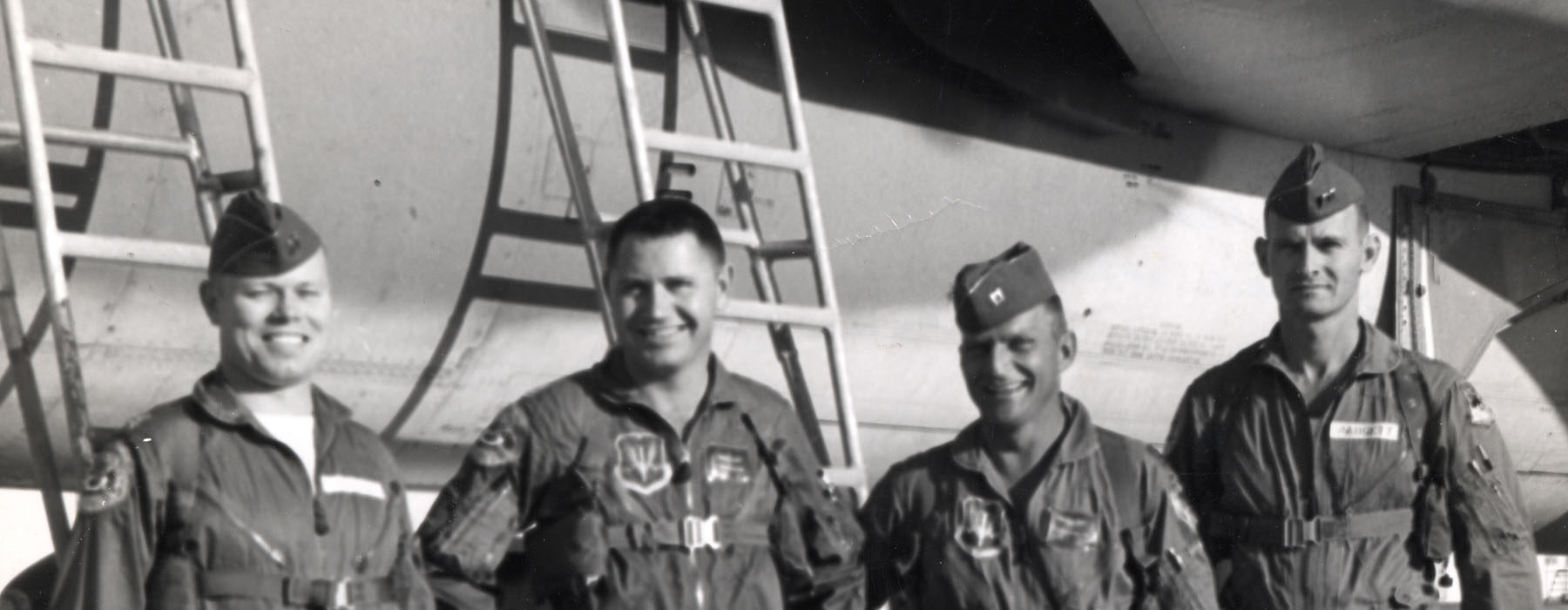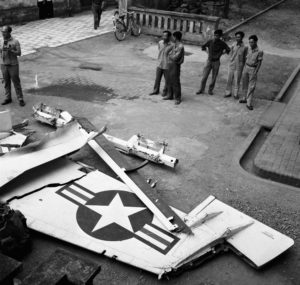 |
| The wreckage of a US Navy A-6 Intruder draws a crowd of North Vietnamese in 1968. USAF’s aircraft losses were devastating, and the Navy and Marine Corps also lost many aircraft. (Scherbakov/RIA Novosti photo) |
As recently as the Vietnam War, USAF and the United States struggled to control the air, failed to achieve safety from enemy air defenses, and struggled to overcome an adversary air force. Many of the problems were self-inflicted, but the fact remains that the years 1964 to 1973 were tremendously difficult for the Air Force and American airpower.
The airspace over Vietnam was a lethal environment for airmen. At times, the USAF advantage in air-to-air combat slipped perilously close to parity. Airmen paid the price in aircraft down, lives lost, and survivors taken prisoner.
Overall, USAF lost 2,254 fixed wing aircraft from February 1962 to October 1973 in the Southeast Asia theater of operations. Some 1,737 fixed wing aircraft were combat losses, and another 517 aircraft went down in related noncombat operations. Losses occurred nearly every day. It was rare for a week to pass without an aircraft lost in combat operations.
Some of the cumulative totals were shocking: The Air Force lost 40 percent of its total production of F-105s to combat in Vietnam. Approximately one out of every eight F-4s ever built by McDonnell Douglas—for all services—was destroyed in Vietnam.
The North Vietnamese Air Force (VPAF) had between 60 and 75 aircraft in service at most points during the war. Yet the MiG-17s, MiG-19s, and MiG-21s shot down 67 USAF aircraft against a loss of 137 of their own, leaving the US Air Force with barely a two-to-one exchange ratio over the course of the war.
What led a nation with such an enormous technological and industrial edge to suffer such air losses
Part of the answer was the mission itself. As the war escalated, more US ground forces deployed. They soon required emergency close air support plus air interdiction, seeking out enemy vehicles and strongholds. Added to this, major separate campaigns attacked fixed targets and war materiel across North Vietnam and into Laos.
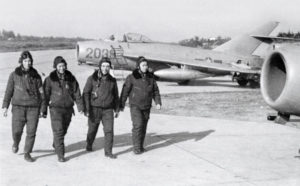 |
| North Vietnamese pilots from the 923rd Fighter Regiment walk past a MiG-17. Pilots flying MiGs shot down 67 US aircraft. North Vietnam lost 137 of theirs. (via Vietnamese News Agency) |
Air operations peaked with ground operations from 1966 to 1968. The Air Force flew a total of 101,089 combat and combat support sorties in 1967, its busiest year. Losses piled up as airmen took risks to complete ground support missions. Ultimately, more than 83 percent of USAF’s total combat losses were to ground fire—mostly anti-aircraft guns.
Now-retired USAF Chief of Staff Gen. Merrill A. McPeak saw it first-hand. Many aircraft were lost to gunfire because they were slow movers, he wrote in his memoir, Hangar Flying. But “guns also bagged lots of modern fighters, not all of them flown by careless or inept pilots,” he said. In his view, the compromises required to handle surface-to-air missiles made US aircraft more vulnerable to guns and interceptors.
China and Russia
The volume of losses tracked with number of sorties flown. But there were other factors. The lethality of the air war derived from the deadly combination of anti-aircraft fire, SAMs, and handfuls of MiGs creating a multilayered problem for strike packages.
A small number of MiGs inflicted some of the most intriguing lessons of the war.
The aerial combat war in Vietnam had two major phases—from the first kills of mid-1965 to 1968, and then again from December 1971 to December 1972.
North Vietnam had begun building its air force after driving out the French in 1954. Several main airbases such as the new jet field at Yen Bai in the North were built in the late 1950s and early 1960s.
China and the Soviet Union supplied aircraft, air defenses, and fighter training. According to Istvan Toperczer’s definitive MiG-17 and MiG-19 Units of the Vietnam War, pilot training began in the late 1950s and continued through the war. Vietnamese pilots took Russian language lessons and ground school at Bataysk, Russia, then transferred to Primorsko-Akhtarsk for flight training in the Yak-18 or later the L-29. At “Ahtari” base, Vietnamese pilots were forgiven for flight training mishaps and given preference over comrades from Hungary, Cuba, and other countries because of the urgency of returning them to their fight back home.
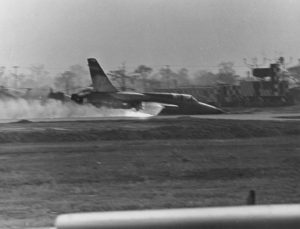 |
| An F-105 “Thud” crash-lands at Udorn RTAB, Thailand, in 1967. Forty percent of the F-105 inventory was lost during the war. (Photo via Bert Hester, www.preservingourhistory.com) |
By the early 1960s, North Vietnam also had pilots training on the MiG-17 in China—with Chinese pilots flying and fighting in North Vietnamese airspace at the beginning of the war.
Records indicate that the first air-to-air kills by MiGs were credited to Chinese pilots. Fortunately, these were kills of the AQM-34 Firebee reconnaissance drones.
The year 1965 marked the beginning of steady losses to anti-aircraft fire, surface-to-air missiles, and MiGs. Among the first USAF losses were more Firebees. By mid-1965, several manned aircraft were lost due to ground fire, lack of fuel, mishaps, and other causes, and many aircrews were already prisoners of war.
The increasing pace of flights provided a target-rich environment for North Vietnam. On June 20, 1965, a USAF F-4C based at Ubon RTAB, Thailand, was shot down. This was the first F-4C lost in combat.
Navy A-1 Skyraiders from USS Midway were among those launched as part of the rescue air patrol when they, too, encountered MiG-17s. “At 12,000 feet and [196 mph] we looked like Tweetybird to Sylvester the Cat,” recalled Navy Reserve pilot Capt. Clinton B. Johnson in a widely reprinted memoir. “Our only hope was to get down low and try to outturn the MiGs.”
Chasing MiGs at low altitude, Johnson and his wingman flew around a hill to see a MiG-17 ahead of them lining up on other A-1s. When they fired a short burst, the MiG-17 “turned hard into us to make a head-on pass.” The Navy pilots gunned him for the kill.
These were deliberate tactics. Flying MiGs that day were members of North Vietnam’s 921st Fighter Regiment, a unit whose pilots were in action for nearly a year by then. “A handful of young, inexperienced pilots would be flying obsolete aircraft against a numerically and technically superior enemy,” wrote Toperczer of the regiment. But they had an advantage: “They would be flying over their own territory, with backup, however limited, from radar and anti-aircraft units.”
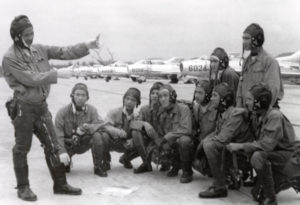 |
| In front of Chinese-made MiG-19s, North Vietnamese pilots listen to a briefing on dogfighting tactics. The MiG-21 superceded the MiG-19. (Via Vietnamese News Agency) |
The Vietnamese pilots of the 921st called the MiG-17s “Silver Swallows” for their bright metal fuselages. USAF Col. Robin Olds called the MiG-17 “a vicious, vicious little beast.”
Rules of Engagement
British historian Christopher M. Hobson believed the North made a careful decision about how and when to use its precious MiGs. “The MiG force was held back until the Rolling Thunder strikes began to reach the 20th parallel,” wrote Hobson in his book Vietnam Air Losses.
Day 1 of the air-to-air war might be traced to April 4, 1965. On that day, MiG-17s surprised and mauled flights of F-105s on a mass raid to bomb the Thanh Hoa Bridge. Four MiG-17s dove across a package of F-105s then disengaged. Down went two F-105s, with both pilots killed.
This was the first blast of the classic hit-and-run tactics MiGs would use throughout the war. They took shots but preserved aircraft for future opportunities, which were sure to come as the US flew more and more sorties. As long as the US rules of engagement barred strikes on their bases, the MiGs could operate almost at will as raiders and stretch their small aircraft force into a thin but consistent threat.
The MiG-17 was a known gun killer. It carried three 23 mm cannons; some of the airplanes were later modified with a radar scope. A direct descendant of the MiG-15 of Korean War fame, the MiG-17 also took advantage of the light weight and maneuverability characteristics of the MiG family.
Over time, the numbers added up. Pilots such as Nguyen Van Bay capitalized on the MiG being swift, small, and hard to spot. Van Bay claimed seven kills in the MiG-17. At least five matched US records, making him North Vietnam’s top Fresco ace.
The US response was to implement combat air patrols to keep the airspace open. Numbers again made the task harder for the US. Not knowing where the MiGs might pop up, combat air patrols had to be in place to cover every mission from bombing to rescue operations. For years it took bases in South Vietnam, bases in Thailand, and carriers on station to provide enough fighters to keep airspace open for aircraft on interdiction and CAS missions.
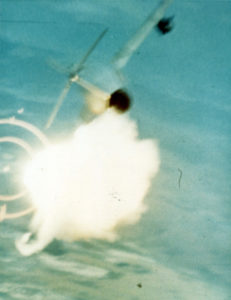 |
| A USAF fighter pilot’s gun camera records the destruction of a MiG as the left wing erupts in flames and disintegrates. (USAF photo) |
Soon, along came the MiG-21.
The MiG-21 was an all-new supersonic jet nearly twice as fast as the MiG-17. The MiG-21 also carried the heat-seeking K-13 Atoll missile, which its pilots used effectively.
The MiG-21 came into use in early 1966. One of the first encounters between a USAF F-105 and a MiG-21 ended as an instructive tale. The USAF pilot locked in combat with the MiG-21 ran out of fuel and had to eject. The F-105 was chalked up as a victory for the North Vietnamese pilot, who was able to return to base.
To the North Vietnamese, the primary value of MiGs lay in combining layered anti-aircraft fire and SA-2s with a few, well-trained flights guided by disciplined tactics. When plans came together they imposed high costs on US forces.
In response, Olds’ Operation Bolo bagged seven MiGs in one day in a dramatic engagement in January 1967. “The MiGs seemed to be hiding after Bolo,” Olds later wrote. “We wouldn’t see any again until the middle of March.”
But suppression was an ongoing task. Olds, even after Bolo, described the environment as worse than anything he’d seen as a 22-year-old squadron commander fighting over Europe in World War II.
“Missiles streaked past, flak blackened the sky, tracers laced patterns across my canopy, and then, capping the day, MiGs would suddenly appear—small, sleek sharks, cutting and slashing, braving their own flak, firing missiles, guns, harassing, pecking,” he wrote in his memoir, Fighter Pilot.
Just a few months later, MiG-17 pilot Van Bay led the 923rd Fighter Regiment pilots through several days of effective engagements. On April 19, 1967, MiG-17s engaged and shot down an F-105. Maj. Leo K. Thorsness pursued another MiG and shot it down with guns. Thorsness intercepted more MiGs lining up for an attack and nearly ran himself out of fuel while acting as a decoy to save other airmen. For his heroic acts, Thorsness was awarded the Medal of Honor.
Wrong Aircraft for the Mission
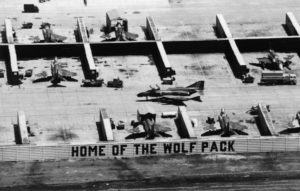 |
| Revetments and F-4s of the 8th Tactical Fighter Wing—the “Wolf Pack”—line the ramp at Ubon RTAB, Thailand. The US flew combat air patrol missions from bases in Thailand, South Vietnam, and carriers. (USAF photos) |
However, North Vietnam’s 921st and 923rd Fighter Regiments weren’t done with their little operational surge. On April 24, eight MiG-17s surprised a package of Navy F-4s attacking Kep, north of Hanoi. The F-4s first ran into heavy AAA, then MiG-17s. The MiGs took advantage of strike packages heading for identified locations and lurked in wait—adding extra menace in an environment already filled with lethal ground-based defenses.
While the MiGs provided suitable home defense, USAF was discovering it had entered the war with air forces that were not as good a fit for their current missions. Most aircraft types were built for Cold War operations, not counterinsurgency warfare.
One stalwart, the A-1 Skyraider was not built even for the Cold War. It was a World War II design, which first flew in March 1945 with the idea of carrying a 2,000-pound bomb on a 1,000-mile flight from carriers to Tokyo if need be. Instead, the Skyraider pilots found themselves strafing, covering rescues, and chasing MiGs. The Air Force lost 150 A-1s in combat, while the Navy lost another 65 and the South Vietnamese Air Force lost 225.
Perhaps the most severe operational disappointment was the F-105. The “Thud” was designed for a nuclear bombing mission, so its wing loading deliberately cut corners on maneuverability. “The Thunderchief was designed to fight a nuclear war in which the delivery of one nuclear weapon at low altitude and high speed was all that was required,” wrote military aviation historian Kenneth P. Werrell in 1998.
The F-105s were powerful bombers but vulnerable to guns, MiGs, and SAMs. The Vietnam War claimed 334 F-105s as combat losses, out of a total production run of 833 aircraft for an astonishing attrition rate of 40 percent. Twenty-three F-105s fell to MiGs, while SA-2s took out 31 more.
Despite those numbers, it was not the F-105 but the F-4 that suffered the highest Air Force losses. A gruesome 382 F-4s fell in combat, while total losses reached 445 when other operational losses were included. Adding Navy and Marine Corps Phantom losses put the number of F-4s lost at 671. This was 12 percent of the fleet—or the equivalent of one out of every eight of the F-4s ever produced.
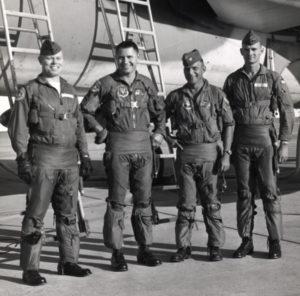 |
| F-105 pilots (l-r): Capt. Harold Johnson, Maj. Leo Thorsness, Capt. Larry Waller, and Capt. James Padgett at Nellis AFB, Nev., in 1966, just before deploying to Takhli RTAB, Thailand. Johnson and Thorsness were shot down in April 1967, and Padgett was shot down in 1972. They spent the rest of the war as POWs. (USAF photos) |
The C-130 was a much better matchup of aircraft to the Vietnam mission, but even so, 60 of the cargo lifters were lost in the war. With them, 395 crew members lost their lives.
For fighters and bombers, the combination of layered defenses and the critical ground support mission stoked continuing losses. The debut of the SA-2 in Vietnam erased any medium- or high-altitude sanctuary from anti-aircraft fire. SAM suppression could be a lethal business, too, as was the case when six F-105s from Takhli Royal Thai Air Base and Korat RTAB, Thailand, were lost in raids on SAM sites on July 27, 1965.
Still debated and controversial is the role the People’s Republic of China played in the US-Vietnam air losses. China served as a supplier of equipment and training, and their personnel manned anti-aircraft batteries for long periods. Chinese sources claim its crews fought 558 battles against US aircraft and had a hand in shooting down 597. Given the hundreds of attack and fighter aircraft lost to anti-aircraft fire, the numbers claimed are not outrageous.
Also intriguing are the few cases of Chinese pilots in air-to-air combat against the US, and American airmen had already met Chinese pilots in the skies over Korea.
Vietnam is on China’s border and stray drones and aircraft often met their fate at the hands of People’s Liberation Army Air Force MiGs. According to historian Walter J. Boyne, the PLAAF provided “much training and assistance” to North Vietnam and gleaned experience for their own purposes, too. “On a number of occasions, the PLAAF shot down US aircraft that had strayed into Chinese airspace,” Boyne observed.
Woefully Unprepared
Chinese MiGs shot down seven Air Force and Navy aircraft from 1965 to 1968, by Hobson’s count. Another source added at least a dozen AQM-34 Firebees to the count through 1967.
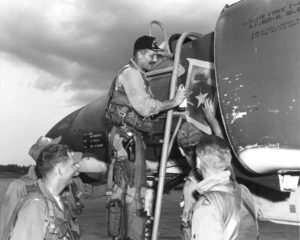 |
| Col. Robin Olds paints a victory star on an F-4 he flew while downing a MiG-21. The F-4 suffered the highest USAF aircraft loss total of the war. (USAF photos) |
Whatever role China played, it was largely over by the late 1960s, as the Cultural Revolution disrupted even China’s military, and activity by Chinese pilots declined. China and North Vietnam also came to be at odds in the Sino-Soviet split.
The Air Force’s aerial combat losses paused after 1968, but losses to ground fire continued. Records of those years show the same steady rates of attrition.
“High threat” was a relative term. McPeak’s “Misty” forward air controller unit lost 14 aircraft in the first half of 1969 alone. Loss rates were lower in 1970 and 1971 in particular, but USAF still lost nearly 247 aircraft in those two years.
A typical example from these years came on June 18, 1970. An F-4E strafing a truck on a road in Cambodia was struck by small-arms fire. The Phantom was flying so low it crashed before the crew could eject. Similar stories often involved pilots making a third or fourth strafing run over a target area.
Forward air controller units also continued to take losses during the war’s two quieter years. In June 1970, an OV-10A Bronco went down in Laos, and the Jolly Green HH-53 sent to pick up the airmen was itself shot down, killing all crew onboard.
Still, the Vietnam air war had one last violent chapter left. In 1972, US airpower surged back to the region to fend off North Vietnam’s spring offensive and then to drive home the culminating pressure of Linebacker II. The Air Force lost another 195 aircraft in 1972 while the Navy lost 91 and the Marines lost 22.
The darkest years of the war did bring on some tactical fixes. Air combat with the agile MiGs vectored by ground control inspired the US to replicate the threat at USAF’s Red Flag and the Navy’s Topgun school. The idea in both cases was to get back to fundamentals of air combat maneuver and training and to give pilots their first deadly combat exposure in a controlled setting.
The larger issue showcased the inherent advantage for Vietnam of fighting over its own territory. Werrell did not flinch from concluding USAF was “woefully unprepared” for Vietnam because of its focus on the nuclear mission. Certainly airmen did all they could to improve tactics and integrate technological fixes during the war.
In Werrell’s view, USAF “rose to the challenge of the war in Vietnam but paid a high price.”
The air losses left a permanent mark on future planning for airpower operations. American reckoning with how a small air force could inflict such losses influenced the next generation of US fighter design—and especially the F-15 Eagle.
